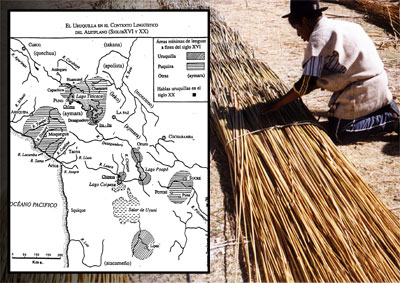A REED BOAT AND TOURIST HOUSES
FOR THE URU PEOPLE OF IROHITO COMMUNITY
Introduction
Irohito (“Roughgrass Corner”) is a small village of Uru people living beside the River Desaguadero that flows southwards out of Lake Titicaca in Bolivia, near the Peruvian border. Many lakeside communities in the region still identify themselves as Urus, although they have been surrounded and dominated historically by the more powerful Aymara farmers of the region, and at a wider level by the mixed and white populations that wielded political power in the Bolivian nation-state until the political changes of December 2005.

Centuries ago, the Urus were the first people to settle in the Altiplano region, and Uru settlements populated the whole region, long before the arrival of Aymaras and Quechuas. In fact, the Urus were probably the founders of many of the early cultures of the region, such as Tiwanaku, and Wankarani, whose ruins are close by. Despite fears a century ago that they were in danger of extinction, there are currently some 7000 Urus living in Bolivia, although at any one time many of them are visiting neighbouring Chile for paid work, education and military service. Of these some 2000 speak the Uru language.
The 151 inhabitants of Irohito, living in 5 extended families, have little farming land, and many live by hunting and gathering from River Desaguadero, which they have done from time immemorial. This is why they are called the “Water people”: Qut zuñi in their own language. Most of these inhabitants now speak Aymara and Spanish, but they still maintain their distinct cultural and linguistic identity in their customs, diet, clothing, music and their language, called uchu mataqu, remembered by a handful of speakers.
In the recent past, the Bolivian government and national authorities systematically ignored the existence and needs of the Uru people, who live in conditions of extreme hardship. So, in 1991 the Urus as a whole declared themselves a “Nation”, presenting a written Constitution in their own language. Under their own initiative, and in collaboration with other Uru groups (including the Uru Morato who live around Lake Poopó, and the Chipaya around Lake Coipasa and River Lauca) they formed a larger politico-administrative unit called a “Mancommunity” to give them the political clout to launch development projects for their region. In the 2004 elections they formed an “Indigenous District” in the wider Municipality of Jesús de Machaqa (Prov. Ingavi in the Dept. of La Paz).
The people of Irohito are developing eco-tourism along the local Rivers and among the Uru communities who live around Lake Titicaca. These include the settlements of Janq'u Jaqi to the east, Ayllu Yaru to the west, Desaguadero, San Pedro Tana, Janq'u jaqitana, and Awalla Maya to the north, and Taraqu, Uma Marka, Isla Sikuya, Uma Marka, and Suriqi around Lake Titicaca (where Thor Heyerdahl’s famous Kon Tiki was made). This makes up an overall population of some 800 people who benefit from this project in material terms, and in consolidating their cultural identity.
At present, the region is seriously underdeveloped but has enormous tourist potential. With the important archaeological sites of Tiwanaku and Wankarani nearby, and the beautiful land- and waterscapes of River Desaguadero and Lake Titicaca immediately at hand, what is needed is of the building of entrepreneurial attitudes, and the combining of business and community administration. There is already a link-up with the Hotel Torino in La Paz, with its course in Tourism and Hotel Management that could guarantee a permanent flow of visitors throughout the year. The community of Irohito is only 105km., and 2 1/2 hours drive from La Paz, along a paved road to Guaqui, and then for 25 km along dirt roads. There is already a small museum of Uru handicrafts in the village of Irohito, and the region has recently become part of a wider Tourist Strategy around the Lakeside proposed by municipal and national governments.
Fax: La Paz (00 591 2) 2 419661 - Correo Electrónico: ilcanet@ilcanet.org

